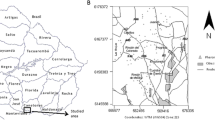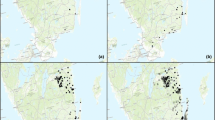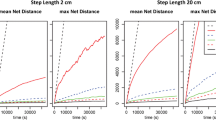Abstract
Traps baited with synthetic pheromones are in widespread use in the survey and detection of the gypsy moth, Lymantria dispar (L.) and other important insect pests in many parts of the world. In the United States approximately 95,000 pheromone traps were deployed to monitor the gypsy moth in 1979. Pheromone traps offer several advantages over other methods of sampling populations. First, such traps are relatively inexpensive and easy to deploy. Gypsy moth traps can be set in place early in the summer and left untended until early fall. Second, pheromone traps generally catch only the target species. The time-consuming sorting to species required for other kinds of traps is avoided. Third, pheromone traps are effective at extremely low population densities. Other sampling methods for the gypsy moth, such as egg mass surveys or collecting pupae in burlap bands wrapped around tree trunks, are impractical when density is low or the area to be surveyed is large.
Access this chapter
Tax calculation will be finalised at checkout
Purchases are for personal use only
Preview
Unable to display preview. Download preview PDF.
Similar content being viewed by others
References
Aeree, F., Jr., 1953. The isolation of gyptol, the sex attractant of the female gypsy moth, J. Econ. Entornol., 46: 313.
Bailey, N. T. J., 1951, On estimating the size of mobile populations from recapture data, Biometrika, 38: 293.
Baker, T. C., Cardé, R. T., and Croft, B. A., 1980, Relationship between pheromone trap capture and emergence of adult Oriental fruit moths, Grapholitha molesta (Lepidoptera: Tortricidae), Can. Entomol., 112: 11.
Bierl, B. A., Beroza, M., and Collier, C. W., 1970, Potent sex attractant of the gypsy moth, Porthetria dispar (L): Its isolation, identification, and synthesis, Science, 170: 87.
Burgess, A. F., 1940, The value to uninfested states of gypsy moth control and extermination, J. Econ. Entomol., 33: 558.
Cardé, R. T., 1979, Behavioral responses of moths to female-produced pheromones and the utilization of attractant-baited traps for population monitoring, in “Movement of Highly Mobile Insects: Concepts and Methodology in Research,” R. L. Rabb and G. G. Kennedy, eds., North Carolina State University Press, Raleigh.
Cardé, R. T., Doane, C. C., Granett, J., Hill, A. S., Kochansky, J., and Roelofs, W. L., 1977a, Attractancy of racemic disparlure and certain analogues to male gypsy moths and the effect of trap placement, Environ. Entomol., 6: 765. Cardé, R. T., Doane, C. C., Baker, T. C., Iwaki, S., and Marumo, S., 1977b, Attractancy of optically active pheromone for male gypsy moths, Environ. Entomol, 6: 768.
Cardé, R. T., and Webster, R., 1979, Variation in attraction of individual gypsy moths to (+) and (-)-disparlure, J. Chem. Ecol., 5: 935.
Collins, C. W., and Potts, S. F., 1932, Attractants for the flying gipsy [sic] moth as an aid in locating new infestations, USDA Tech. Bull., 336.
Darroch, J. N., 1959, The multiple-capture census. II. Estimation where there is immigration or death, Biometrika, 46: 336.
Doane, C. C., 1961, Field tests with gyplure, 1961, Conn. Agric. Exp. Stn. Prog. Rept., 1, 3 pp.
Elkinton, J. S., and Cardé, R. T., 1980, Distribution, dispersal and apparent survival of male gypsy moths as determined by capture in pheromone-baited traps, Environ. Entomol., 9: (In press).
Farnum, D. G., Veysoglu, T., Cardé, A. M., Duhl-Emsweiler, B., Pancoast, T. A., Reitz, T. J., and Cardé, R. T., 1977, A stereo- specific synthesis of (-)-disparlure, sex attractant of the gypsy moth, Tetrahedron Lett., 46: 4009.
Forbush, E. H., and Fernald, C. H., 1896, “The Gypsy Moth,” Wright & Potter Printing Co., Boston.
Granett, J., 1973, A disparlure-baited box trap for capturing large numbers of gypsy moths, J. Econ. Entomol., 66: 359.
Granett, J., 1974, Estimation of male mating potential of gypsy moths with disparlure baited traps, Environ. Entomol., 3: 383.
Haller, H. L., Aeree, F., Jr., and Potts, S. F., 1944, The nature of the sex attractant of the female gypsy moth, J. Am. Chem. Soc., 66: 1659.
Holbrook, R. F., Beroza, M., and Burgess, E. D., 1960, Gypsy moth (Porthetria dispar) detection with the natural female sex lure, J. Econ. Entomol., 53: 751.
Howell, J. F., 1974, The competitive effect of field populations of codling moth on sex attractant trap efficiency, Environ. Entomol. 3: 803.
Iwaki, S., Marumo, S., Saito, T., Yamada, M., and Katagiri, K., 1974, Synthesis and activity of optically active disparlure, J. Am. Chem. Soc., 96: 7842.
Jackson, C. H. N., 1937, Some new methods in the study of Glossina morsitans, Proc. Zool. Soc. London, 1936, 811.
Jacobson, M., and Jones, W. A., 1962, Insect sex attractants. II. The synthesis of a highly potent gypsy moth sex attractant and some related compounds, J. Org. Chem., 27: 2523.
Jacobson, M., Beroza, M., and Jones, W. A., 1960, Isolation, identification, and synthesis of the gypsy moth sex attractant, Science, 132: 1011.
Jacobson, M., Schwarz, M., and Waters, R. M., 1970, Gypsy moth sex attractants: A reinvestigation, J. Econ. Entomol., 63: 943.
Jolly, G. M., 1963, Estimates of population parameters from multiple recapture data with both death and dilution-deterministic model, Biometrika, 50: 113.
Jolly, G. M., 1965, Explicit estimates from capture-recapture data with both death and immigration-stochastic model, Biometrika, 52: 225.
Knipling, E. F., and McGuire, J. U., 1966, Population models to test theoretical effects of sex attractants used for insect control, USDA Agric. Info. Bull. 308.
Leslie, P. H., 1952, The estimation of population parameters from data obtained by means of the capture-recapture method. II. The estimation of total numbers, Biometrika, 39: 363.
Lewis, T., and Macaulay, E. D. M., 1976, Design and evaluation of sex-attractant traps for pea moth Cydia nigricana (Steph.) and the effect of plume shape on catches, Ecol. Entomol., 1: 175.
Maksimovic, M., 1958, A contribution to the investigation of the numerousness of the gypsy moth by means of the trap method [in Serbo-Croation, English summary], Zast. Bilja, 49 /50: 41.
Maksimovic, M., 1965, Sex attractant traps with female odor of the gypsy moth used for forecasting the increase of population of gypsy moth, Proc. 12th Int. Congr. Entomol. 1964, 398.
Manly, B. F. J., and Parr, M. J., 1968, A new method of estimating population size, survivorship, and birth-rate from capture- recapture data, Trans. Soc. Brit. Entomol., 18: 81.
Minks, A. K., 1977, Trapping with behavior-modifying chemicals: Feasibility and limitations, in “Chemical Control of Insect Behavior,” H. H. Shorey and J. J. McKelvey, eds., Wiley- Interscience, New York.
Mori, K., Takigawa, T., and Matsui, M., 1976, Stereoselective synthesis of optically active disparlure, the pheromone of thegypsy moth (Porthetria dispar L.), Tetrahedron Lett, 44: 3953.
Nakamura, K., and Oyama, M., 1978, An equation for the competition between pheromone traps and adult females for adult males, Appl. Entomol. Zool., 13: 176.
ODell, T. M., 1978, Periodicity of eclosion and pre-mating behavior of gypsy moth, Ann. Entomol. Soc. Am., 71: 748.
Petersen, C. G. J., 1896, The yearly immigration of young plaice into Limfjord from the German sea, etc., Rept. Danish Biol. Stn., 6: 1.
Pirkle, W. H., and Rinaldi, P. L., 1979, Synthesis and enantiomericpurity determination of the optically active epoxide disparlure, sex pheromone of the gypsy moth, J. Org. Chem., 44: 1025.
Plimmer, J. R., Schwalbe, C. P., Paszek, E. C., Bierl, B. A., Webb, R. E., Marumo, S., and Iwaki, S., 1977, Contrasting effectiveness of (+) and (-) enantiomers of disparlure for trapping native populations of the gypsy moth in Massachusetts, Environ.Entomol., 6: 518.
Richerson, J. V., and Cameron, E. A., 1974, Differences in pheromone release and sexual behavior between laboratory-reared and wild gypsy moth adults, Environ. Entomol., 3: 475.
Ricker, W. E., 1975, Computations and interpretation of biological statistics of fish populations, Bull. Fish. Res. Board Can. 191, 382 pp.
Schwalbe, C. P., 1979, Using pheromone traps to detect and evaluate populations of the gypsy moth, USDA Agric. Handbook 544, 11 pp.
Schwalbe, C. P., 1980, Disparlure-baited traps for survey and detection, in: “The Gypsy Moth: Research Toward Integrated Pest Management,” USDA Tech. Bull. 1584, (In Press).
Seber, G. A. F., 1962, The multi-sampling single recapture census, Biometrika, 49: 339.
Welch, S. M., Croft, B. A., Brunner, J. F., and Michels, M. F., 1978, PETE: An extension phenology modeling system for management of multi-species pest complex, Environ. Entomol., 7: 487.
Author information
Authors and Affiliations
Editor information
Editors and Affiliations
Rights and permissions
Copyright information
© 1981 Plenum Press, New York
About this chapter
Cite this chapter
Elkinton, J.S., Cardé, R.T. (1981). The Use of Pheromone Traps to Monitor Distribution and Population Trends of the Gypsy Moth. In: Mitchell, E.R. (eds) Management of Insect Pests with Semiochemicals. Springer, Boston, MA. https://doi.org/10.1007/978-1-4613-3216-9_5
Download citation
DOI: https://doi.org/10.1007/978-1-4613-3216-9_5
Publisher Name: Springer, Boston, MA
Print ISBN: 978-1-4613-3218-3
Online ISBN: 978-1-4613-3216-9
eBook Packages: Springer Book Archive




